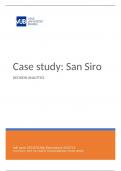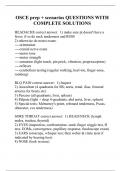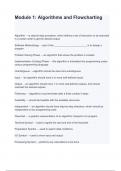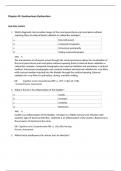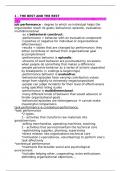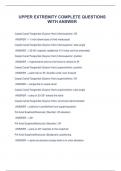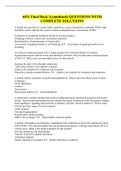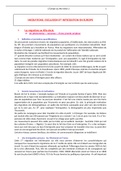Summary Advanced Separation Sciences
Field Flow Fractionating (FFF):
- Elution order: small → medium → large
- Field applied perpendicular to transport flow within a channel
- No stationary phase
- Laminar flow, parabolic profile
- Brownian motion, diffusion coefficient Df
- Low shear forces → tangential shear → higher-order structures,
especially those prone to shear stress
- Mw range 103 – 1010 g/mol
- Measures wide range of physicochemical properties
Differences chromatography and FFF:
- All chromatographic separations are based on the partitioning of components
between two immiscible phases
- Separation at depends only on the conformational entropy change when
macromolecule diffuses from the interstitial volume into the pores of packing, and
back out again → no enthalpic interactions
- FFF: separation based on coupling of velocity non-uniformities and concentration
non-uniformities
Different localizations of particles due to diffusion → end up in different velocities of flow →
different retention times
Principle: components elute at different speeds depending on D and position in channel
- Retention and separation caused by an external field,
perpendicular to the axial flow
- Separation based on differences in diffusion coefficients of
analytes → Brownian
- Field strength can be precisely controlled
- Particles driven by the field to different localized regions in
the channel and displaced downstream at a velocity equal
to the mean parabolic flow velocity in that region
- Particles are carried out towards the detector at different
speeds → different times
,Asymmetrical FFF: AF4
- Possible to detect larger aggregates, higher reproducibility and no protein adsorption
- One flow inlet, two flow outlets
- Only one permeable wall supporting the membrane for transversal flow exiting the
channel via the accumulation wall
- Fin = Fcr + Fch Fcr: cross flow Fch: flow out
- Field created by splitting the longitudinal flow to generate the cross flow that
permeates the accumulation wall
- Geometries:
- Channel: peak dilution reduces, lower LODs and faster separations
- Cylindrical: hallow fibers = HF5
- Detection: triple detection: UV/fluorescence, RI and MALS
- UV/fluorescence: concentration, hydrodynamic size
- Multi angle light scattering (MALS) + RI: particle size distribution and molar mass
- Mass spectrometry: chemical and structure identification → advantage e.g. TOF is
fast detection method, preferred as FFF is slow
- Asymmetric as the glass upper plate is nonpermeable to the carrier and it has a
permeable lower plate
AF4 procedure:
1. Sample injection:
Vinj = Finj x tinj > 5 x (Vsample + Vtubing)
2. Focusing / relaxation:
- Both channel-in and channel-out ports pump liquid into channel at same time
- Point of focusing determined by Fleft/Fright
- Essential for minimizing band broadening
- Analytes relax into a steady state before being transported to the detector
- Gaussian distribution of components around focusing point
- Occurs through Brownian motion in response to cross flow induced
- Focusing time: typically 2-6 min
- ‘Vertical’ relaxation: by induced cross-flow
- ‘Horizontal’ focusing: by applied channel flows
- Disadvantages: takes time, risk of material loss, adsorption to membrane and
interactions between analytes
- Advantages: less peak broadening and possibilities for sample pre-concentration
3. Elution:
- Molecules are transported to detector by laminar flow and pushed to membrane by
induced crossflow
- Components start to separate based on differences in diffusion coefficients (D)
- High D → high distance from wall → faster elution (in Brownian mode)
Effect of field:
- Causes analyte to move towards the accumulation wall at velocity u cr
- Diffusion forces: oppose the resulting build-up in concentration
𝐷
- 𝑙𝑖 = 𝑢 𝑖
𝑐𝑟
l: characteristic layer thickness; mean distance of molecules in steady state from wall
- Steady state establishes when opposing forces ucr and D are balanced
, - Low Mw → high D → in higher velocity of laminar flow, elute first
- High Mw → low D → closer to wall, lower stream velocity, elute last
- Behavior of analytes affected by D and strength of applied field
- l can be modified by tuning the applied fiend
Normal vs steric mode:
- Normal mode (Brownian elution): elution depends on D and field strength
→ small particles elute first
- Steric mode: particles too large to be affected by cross-flow → will protrude out of
the accumulation layer into faster streamlines and exit the separator faster than
small particles
→ elution depends on particle radius and spacer thickness (w)
Effect of flow:
2
- 𝑣0 = 3 𝑣𝑚𝑎𝑥
𝑥
- 𝑥 → 0: 𝑣(𝑥) = 6 𝑤 𝑣0
𝑙
- 𝑣𝑖 ≈ 𝑣(𝑙) = 6 𝑤𝑖 𝑣0
1 𝑤 1 𝑤∙𝑢𝑐𝑟
- 𝑡𝑅,𝑖 = 6 ∙ 𝑙 𝑡0 = 6 ∙ 𝑡0
𝑖 𝐷𝑖
𝑙 𝐷𝑖
- Retention factor: 𝜆 = 𝑤𝑖 = 𝑢
𝑐𝑟 ∙𝑤
- Approximation: 𝑣𝑖 ≈ 𝑣(𝑙) = 6 ∙ 𝜆 ∙ 𝑣0
𝑤2 𝐹
- Elution time in AF4: 𝑡𝑅,𝑖 = 6𝐷 ∙ ln (1 + 𝐹𝑐𝑟 )
𝑖 𝑐ℎ
𝑘𝑇
- Diffusion coefficient: 𝐷 = 6𝜋𝜂𝑟 rH: hydrodynamic radius
𝐻
Measure D and Mw:
- Take standard with known D → make sure < 0.02 → calculate effective w from
retention time for the standard → use this w-value to calculate D for an unknown
component with known retention time → use scaling law to find estimation of M
- D = a * Mw-b
a: calibration constant
b = 0.56 for linear synthetic polymer in good solvent
b = 0.40 for globular proteins in water
for globular proteins: log D = -8.27 – 0.40 log(Mw)
Optimization parameters:
- High Mw compounds with low D elute later
- Fcr/Fch determines retention, not the magnitude of flow rates
- The tinner the space, the lower the retention (at same flow ratio)
- Length of channel does not matter
- By choosing proper flow ratio and spacer thickness, you can get any retention time
you like
Field Flow Fractionating (FFF):
- Elution order: small → medium → large
- Field applied perpendicular to transport flow within a channel
- No stationary phase
- Laminar flow, parabolic profile
- Brownian motion, diffusion coefficient Df
- Low shear forces → tangential shear → higher-order structures,
especially those prone to shear stress
- Mw range 103 – 1010 g/mol
- Measures wide range of physicochemical properties
Differences chromatography and FFF:
- All chromatographic separations are based on the partitioning of components
between two immiscible phases
- Separation at depends only on the conformational entropy change when
macromolecule diffuses from the interstitial volume into the pores of packing, and
back out again → no enthalpic interactions
- FFF: separation based on coupling of velocity non-uniformities and concentration
non-uniformities
Different localizations of particles due to diffusion → end up in different velocities of flow →
different retention times
Principle: components elute at different speeds depending on D and position in channel
- Retention and separation caused by an external field,
perpendicular to the axial flow
- Separation based on differences in diffusion coefficients of
analytes → Brownian
- Field strength can be precisely controlled
- Particles driven by the field to different localized regions in
the channel and displaced downstream at a velocity equal
to the mean parabolic flow velocity in that region
- Particles are carried out towards the detector at different
speeds → different times
,Asymmetrical FFF: AF4
- Possible to detect larger aggregates, higher reproducibility and no protein adsorption
- One flow inlet, two flow outlets
- Only one permeable wall supporting the membrane for transversal flow exiting the
channel via the accumulation wall
- Fin = Fcr + Fch Fcr: cross flow Fch: flow out
- Field created by splitting the longitudinal flow to generate the cross flow that
permeates the accumulation wall
- Geometries:
- Channel: peak dilution reduces, lower LODs and faster separations
- Cylindrical: hallow fibers = HF5
- Detection: triple detection: UV/fluorescence, RI and MALS
- UV/fluorescence: concentration, hydrodynamic size
- Multi angle light scattering (MALS) + RI: particle size distribution and molar mass
- Mass spectrometry: chemical and structure identification → advantage e.g. TOF is
fast detection method, preferred as FFF is slow
- Asymmetric as the glass upper plate is nonpermeable to the carrier and it has a
permeable lower plate
AF4 procedure:
1. Sample injection:
Vinj = Finj x tinj > 5 x (Vsample + Vtubing)
2. Focusing / relaxation:
- Both channel-in and channel-out ports pump liquid into channel at same time
- Point of focusing determined by Fleft/Fright
- Essential for minimizing band broadening
- Analytes relax into a steady state before being transported to the detector
- Gaussian distribution of components around focusing point
- Occurs through Brownian motion in response to cross flow induced
- Focusing time: typically 2-6 min
- ‘Vertical’ relaxation: by induced cross-flow
- ‘Horizontal’ focusing: by applied channel flows
- Disadvantages: takes time, risk of material loss, adsorption to membrane and
interactions between analytes
- Advantages: less peak broadening and possibilities for sample pre-concentration
3. Elution:
- Molecules are transported to detector by laminar flow and pushed to membrane by
induced crossflow
- Components start to separate based on differences in diffusion coefficients (D)
- High D → high distance from wall → faster elution (in Brownian mode)
Effect of field:
- Causes analyte to move towards the accumulation wall at velocity u cr
- Diffusion forces: oppose the resulting build-up in concentration
𝐷
- 𝑙𝑖 = 𝑢 𝑖
𝑐𝑟
l: characteristic layer thickness; mean distance of molecules in steady state from wall
- Steady state establishes when opposing forces ucr and D are balanced
, - Low Mw → high D → in higher velocity of laminar flow, elute first
- High Mw → low D → closer to wall, lower stream velocity, elute last
- Behavior of analytes affected by D and strength of applied field
- l can be modified by tuning the applied fiend
Normal vs steric mode:
- Normal mode (Brownian elution): elution depends on D and field strength
→ small particles elute first
- Steric mode: particles too large to be affected by cross-flow → will protrude out of
the accumulation layer into faster streamlines and exit the separator faster than
small particles
→ elution depends on particle radius and spacer thickness (w)
Effect of flow:
2
- 𝑣0 = 3 𝑣𝑚𝑎𝑥
𝑥
- 𝑥 → 0: 𝑣(𝑥) = 6 𝑤 𝑣0
𝑙
- 𝑣𝑖 ≈ 𝑣(𝑙) = 6 𝑤𝑖 𝑣0
1 𝑤 1 𝑤∙𝑢𝑐𝑟
- 𝑡𝑅,𝑖 = 6 ∙ 𝑙 𝑡0 = 6 ∙ 𝑡0
𝑖 𝐷𝑖
𝑙 𝐷𝑖
- Retention factor: 𝜆 = 𝑤𝑖 = 𝑢
𝑐𝑟 ∙𝑤
- Approximation: 𝑣𝑖 ≈ 𝑣(𝑙) = 6 ∙ 𝜆 ∙ 𝑣0
𝑤2 𝐹
- Elution time in AF4: 𝑡𝑅,𝑖 = 6𝐷 ∙ ln (1 + 𝐹𝑐𝑟 )
𝑖 𝑐ℎ
𝑘𝑇
- Diffusion coefficient: 𝐷 = 6𝜋𝜂𝑟 rH: hydrodynamic radius
𝐻
Measure D and Mw:
- Take standard with known D → make sure < 0.02 → calculate effective w from
retention time for the standard → use this w-value to calculate D for an unknown
component with known retention time → use scaling law to find estimation of M
- D = a * Mw-b
a: calibration constant
b = 0.56 for linear synthetic polymer in good solvent
b = 0.40 for globular proteins in water
for globular proteins: log D = -8.27 – 0.40 log(Mw)
Optimization parameters:
- High Mw compounds with low D elute later
- Fcr/Fch determines retention, not the magnitude of flow rates
- The tinner the space, the lower the retention (at same flow ratio)
- Length of channel does not matter
- By choosing proper flow ratio and spacer thickness, you can get any retention time
you like

